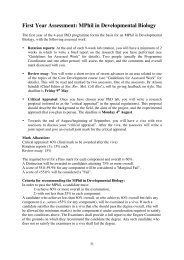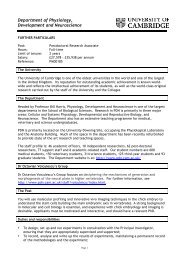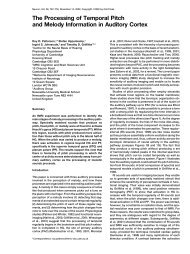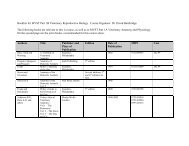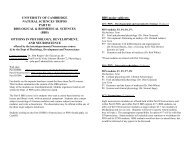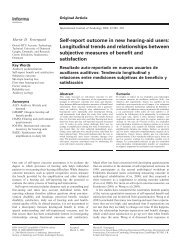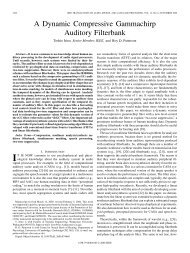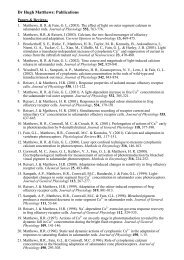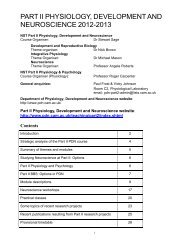FRIDAY MORNING, 20 MAY 2005 REGENCY E, 8:30 A.M. TO 12:00 ...
FRIDAY MORNING, 20 MAY 2005 REGENCY E, 8:30 A.M. TO 12:00 ...
FRIDAY MORNING, 20 MAY 2005 REGENCY E, 8:30 A.M. TO 12:00 ...
You also want an ePaper? Increase the reach of your titles
YUMPU automatically turns print PDFs into web optimized ePapers that Google loves.
1:50<br />
5pAB4. Noise localization ability in the Mongolian gerbil „Meriones<br />
unguiculatus…. Srijata Sarkar, Kristina S. Abrams, and Laurel H. Carney<br />
Inst. for Sensory Res. and Dept. of Biomed. and Chemical Eng., Syracuse<br />
Univ., Syracuse, NY 13244<br />
Understanding localization ability is essential for comparison to physiological<br />
studies of binaural neurons. Heffner and Heffner Beh. Neuro.<br />
102, 422 1998 reported relatively poor ability of the gerbil to localize a<br />
1<strong>00</strong> ms noise burst approximately 75% correct at 27° separation. Their<br />
experimental setup required the gerbil to enter an observing response compartment,<br />
initiating a noise burst from one of two speakers separated by<br />
the test angle. The animal was required to respond by entering a reporting<br />
compartment, positioned 90° to the right or left, regardless of speaker<br />
location. This required mapping from speaker location to response location.<br />
In this study, response mapping was avoided in an effort to improve<br />
performance. After an observing response jumping on a platform in the<br />
center of a circular cage, the animal responded by moving directly towards<br />
the active speaker. The results of this study were consistent with<br />
those of Heffner and Heffner at small angles of separation. For 180°<br />
separation, this task resulted in poorer performance than the previous<br />
study, presumably due to lack of control of head orientation during stimulation,<br />
leading to front-back confusions. In conclusion, the poor localiza<br />
tion ability of gerbils is apparently not explained by response mapping.<br />
Work supported by NIDCD R01-DC<strong>00</strong>1641.<br />
2:05<br />
5pAB5. Strain differences in auditory sensitivity in canaries bred for<br />
song and plumage. Amanda Lauer, Elizabeth Brittan-Powell, Bernard<br />
Lohr, and Robert Dooling Dept. of Psych., Univ. of Maryland, College<br />
Park, MD <strong>20</strong>742<br />
Canaries have been domesticated for well over 1<strong>00</strong> years. They have<br />
been bred for specific characteristics such as song, plumage, or body<br />
shape. Here we measured audiograms in several canary strains using both<br />
behavioral operant conditioning and physiological auditory brainstem<br />
responses methods. Overall, there was a good correspondence between<br />
behavioral and ABR audiograms, but there were differences in audiogram<br />
shape and sensitivity between strains. Belgian Waterslager canaries bred<br />
for low-pitched song had elevated high frequency thresholds, while Spanish<br />
Timbrado canaries bred for high-pitched song had slightly better high<br />
frequency thresholds than canaries that were not bred for song. Other<br />
strains showed intermediate sensitivity. These results suggest there can be<br />
more variability in hearing within a species than previously thought and<br />
that these differences are correlated with other behavioral or morphological<br />
traits. Work supported by DC<strong>00</strong>198, DC<strong>00</strong>1372, DC04664-01A2, and<br />
DC<strong>00</strong>5450.<br />
2:<strong>20</strong>–2:50<br />
Panel Discussion<br />
Panelists: Robert Dooling, Richard Fay, Henry Heffner, Paul Nachtigall, Constantine Trahiotis, William Yost.<br />
<strong>FRIDAY</strong> AFTERNOON, <strong>20</strong> <strong>MAY</strong> <strong>20</strong>05<br />
PLAZA A, 2:<strong>00</strong> <strong>TO</strong> 4:15 P.M.<br />
Session 5pBB<br />
Biomedical UltrasoundÕBioresponse to Vibration and Physical Acoustics: Audible-Frequency Medical<br />
Diagnostic Methods Including Multimode Techniques II<br />
Hans Pasterkamp, Cochair<br />
Pediatrics Dept., Univ. of Manitoba, 840 Sherbrooke St., Winnipeg, MB R3A 1R9, Canada<br />
Thomas J. Royston, Cochair<br />
Dept. of Mechanical Engineering, Univ. of Illinois at Chicago, 842 W. Taylor St., Chicago, IL 60607-7022<br />
Chair’s Introduction—2:<strong>00</strong><br />
Invited Papers<br />
2:05<br />
5pBB1. Monitoring changes of human airways by acoustical means. Hans Pasterkamp Dept. of Pediatrics, Univ. of Manitoba,<br />
CS51<strong>20</strong>-840 Sherbrook St., Winnipeg, MB, Canada R3A 1S1, pasterkamp@umanitoba.ca<br />
The state of human airways is typically assessed by spirometry, i.e., by measuring airflow during maximum forced expiration. The<br />
required effort excludes subjects who cannot or will not perform such maneuvers. Turbulent airflow during normal breathing generates<br />
sound that can be recorded at the chest surface. Changes in airway caliber, e.g., by constriction or dilation, and concurrent changes in<br />
the tension of the airway walls affect the relation of airflow and breath sounds. This relation is complex and incompletely understood.<br />
However, the possibility to assess changes in the state of human airways by the relation of airflow and breath sounds promises an<br />
opportunity to develop auxiliary methods to spirometry. Two regions of the human airways have attracted the interest of researchers<br />
in respiratory acoustics. Breath sounds over the trachea windpipe increase in their airflow-specific intensity on narrowing of the<br />
upper airways, e.g., due to abnormal anatomy, infectious causes etc. Furthermore, spectral characteristics of tracheal sounds may<br />
indicate the region of abnormality. On the other hand, breath sounds over the chest change in their airflow-specific intensity with<br />
constriction of airways in the lung, e.g., due to asthma. It may therefore be possible to monitor the effectiveness of treatment by<br />
acoustical means.<br />
2614 J. Acoust. Soc. Am., Vol. 117, No. 4, Pt. 2, April <strong>20</strong>05 149th Meeting: Acoustical Society of America 2614



